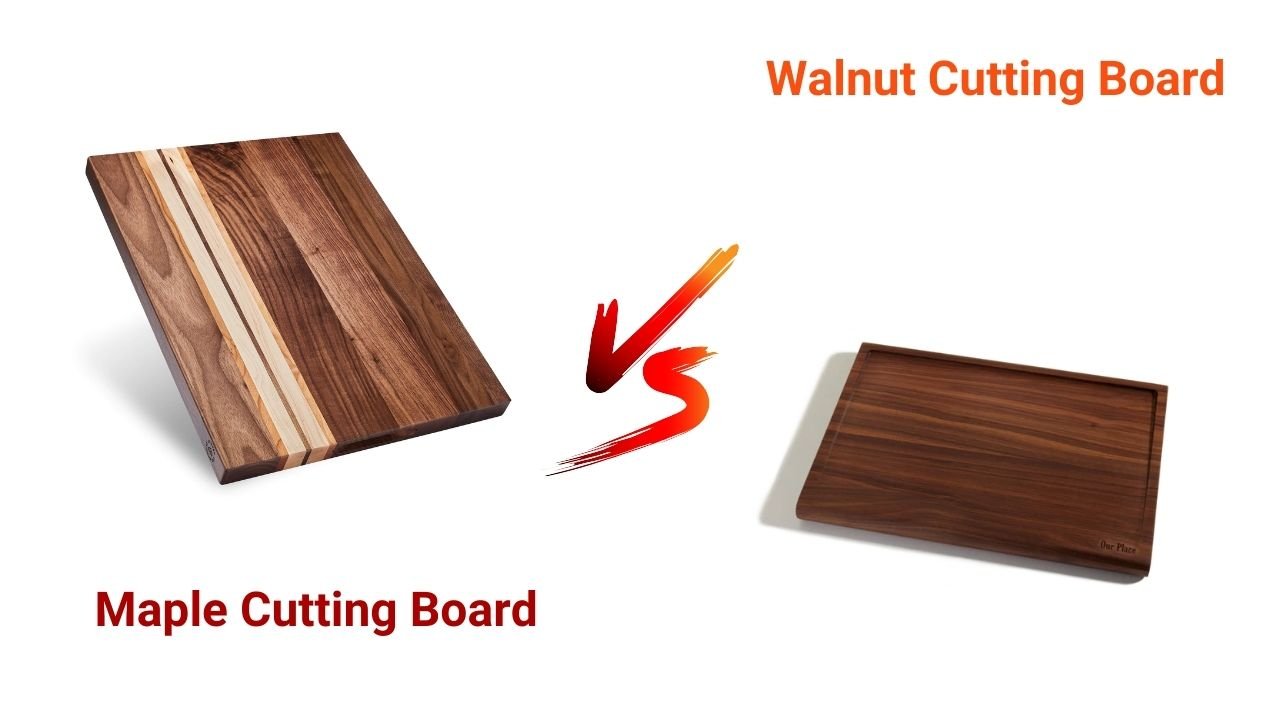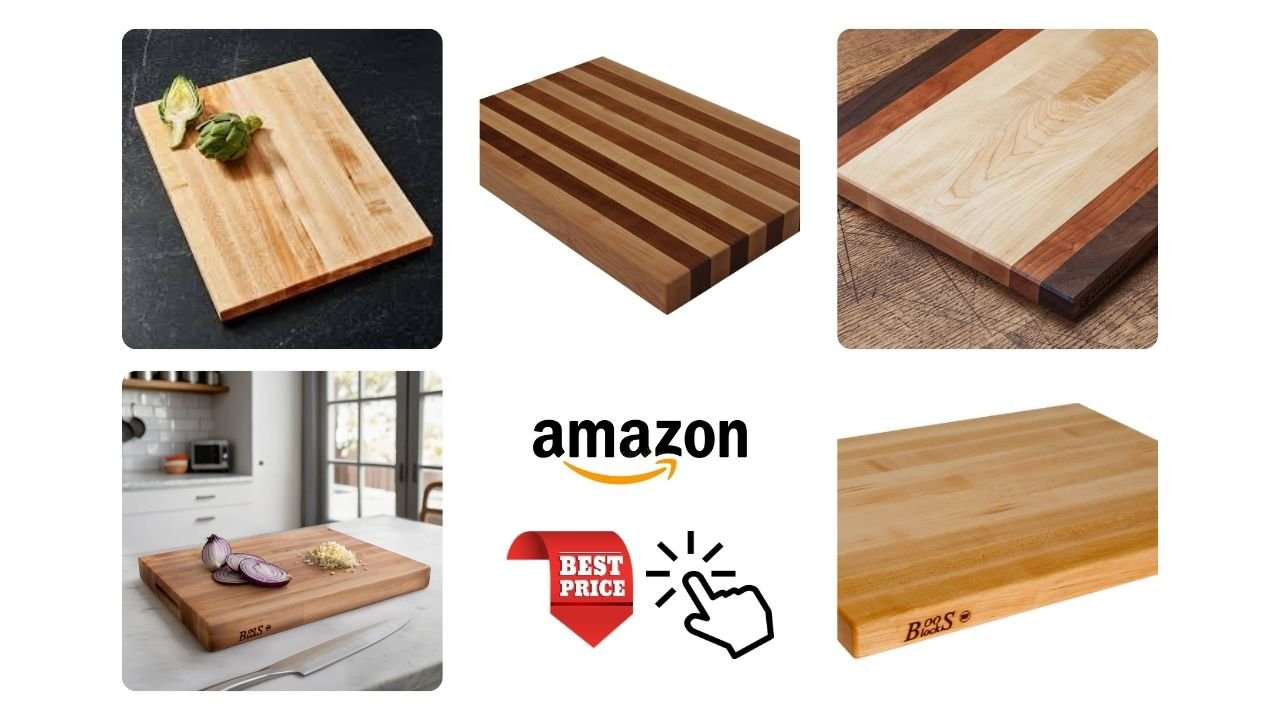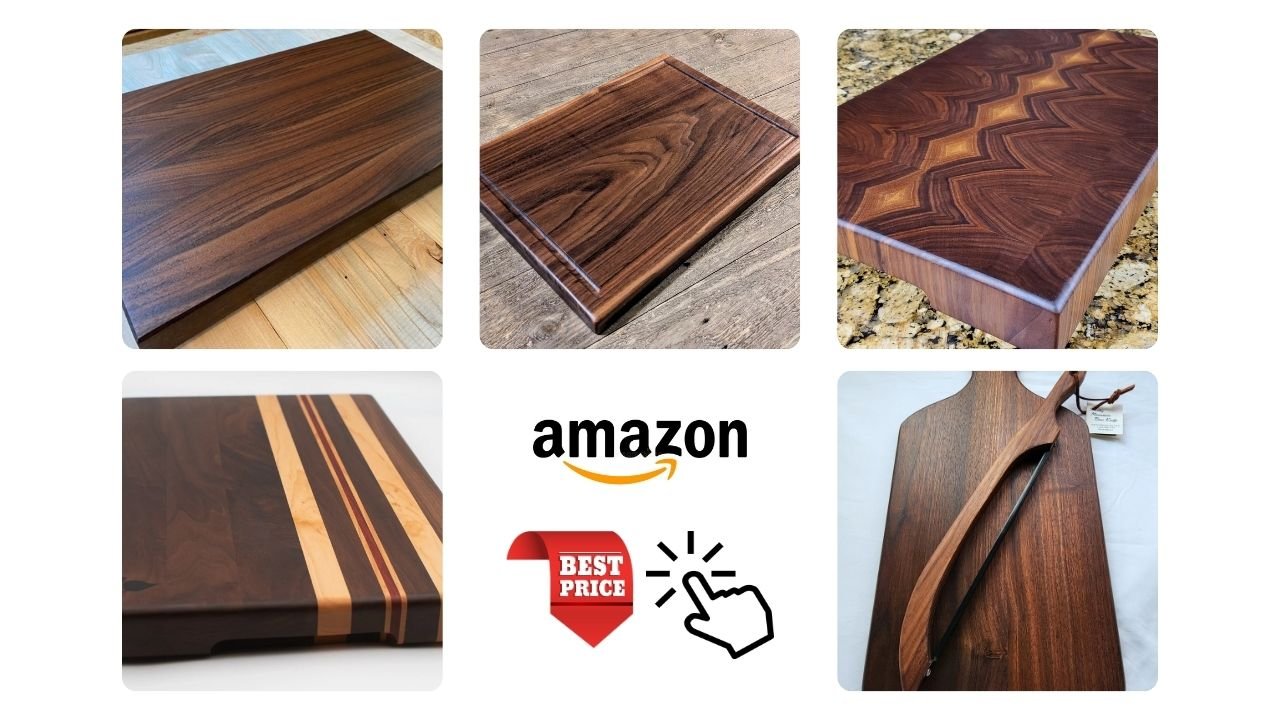When choosing between a Maple vs Walnut Cutting Board, maple is more durable and ideal for heavy use, while walnut offers a softer surface that’s gentler on knives and adds aesthetic appeal.
When it comes to kitchen essentials, a cutting board is one of the most vital tools you can own. Over the years, I’ve tested different types of cutting boards and discovered that the decision between a maple vs walnut cutting board is more than just a matter of preference—it’s about understanding your cooking habits, aesthetic taste, and maintenance willingness.
Both maple cutting boards and walnut cutting boards have their unique strengths, and choosing the right one can elevate your kitchen experience. Maple offers incredible durability and functionality, while walnut impresses with its luxurious appearance and knife-friendly surface. Let me walk you through what I’ve learned after using both, so you can make an informed choice for your kitchen.
Why a High-Quality Cutting Board Matters?
A cutting board is not just a flat surface; it’s a tool that directly impacts your cooking efficiency, your knife’s longevity, and your kitchen’s hygiene. Here’s why investing in a top-quality board—whether maple or walnut—makes all the difference:
- Protects Knives: The right cutting board minimizes wear and tear on your knife edges.
- Improves Cooking Workflow: A stable, well-designed cutting board makes prep work faster and safer.
- Adds to Kitchen Aesthetics: Beautiful boards like walnut or maple can double as serving trays.
- Durability Saves Money: Long-lasting boards prevent the need for frequent replacements.
The Appeal of Maple Cutting Boards
Why I Love Maple Cutting Boards
After months of using a maple cutting board, I’ve come to appreciate its durability, functionality, and eco-friendly features. Maple is one of the hardest woods used for cutting boards, making it ideal for heavy-duty tasks.
- Exceptional Durability: Maple cutting boards are tough, and their dense grain resists scratches and gouges better than softer woods.
- Gentle on Knives: Though harder than walnut, the fine-grain texture ensures it doesn’t excessively dull knives.
- Classic Aesthetic: The creamy, light-colored surface of maple boards complements most kitchen styles.
- Hygienic: Maple’s tightly-packed grain prevents moisture absorption, reducing bacterial growth.
Things to Consider About Maple Cutting Boards
Despite its many advantages, a maple board isn’t without its challenges:
- Weight: Maple cutting boards are heavy, which adds stability but makes handling a bit cumbersome.
- Maintenance: Regular oiling is necessary to prevent cracking and drying.
- Higher Cost: While more affordable than walnut, maple boards are pricier than bamboo or plastic options.
The Elegance of Walnut Cutting Boards
Why Walnut Cutting Boards Stand Out
Switching to a walnut cutting board was a transformative experience for me. Its rich, dark tones and soft surface make it perfect for prepping delicate foods or serving charcuterie.
- Knife-Friendly Surface: Walnut’s slightly softer wood grain minimizes blade dulling.
- Luxurious Aesthetics: The deep chocolate hues and bold patterns elevate any kitchen setup.
- Multi-Functionality: Many walnut boards double as serving platters, making them ideal for entertaining.
- Eco-Friendly: Sustainably sourced walnut boards are both functional and environmentally conscious.
Drawbacks of Walnut Cutting Boards
While walnut boards are beautiful and functional, they do require extra care:
- Higher Maintenance: Walnut boards need frequent oiling to retain their natural luster.
- Shallow Juice Grooves: Many models have grooves that don’t accommodate large amounts of liquid.
- Cost: Walnut cutting boards are among the most expensive, but their longevity makes up for the initial investment.
Maple vs Walnut Cutting Board: A Side-by-Side Comparison

Let’s break down the differences between these two popular options to help you choose the best fit for your needs:
| Feature | Maple Cutting Board | Walnut Cutting Board |
|---|---|---|
| Hardness (Janka Scale) | Harder, ideal for heavy chopping | Softer, protects knife edges |
| Aesthetic Appeal | Light, uniform grain with a clean finish | Rich, dark tones with striking patterns |
| Durability | Extremely durable and scratch-resistant | Durable but more prone to knife marks |
| Weight | Heavier and stable | Lighter, easier to handle |
| Maintenance | Monthly oiling and gentle care | Requires bi-weekly oiling |
| Price | More affordable than walnut | Premium price tag |
Verdict: Maple is better for heavy-duty cooking, while walnut excels in style and knife protection.
My Personal Experience with Maple vs Walnut Cutting Boards
Having used both maple and walnut cutting boards, I can confidently say that each has a place in my kitchen:
- Maple for Cooking: My maple board is the workhorse. It handles everything from chopping dense root vegetables to cutting through meat. The stability and durability make it my go-to for intense prep work.
- Walnut for Serving: On the other hand, my walnut board feels like a piece of art. It’s perfect for lighter tasks like slicing bread or vegetables and shines when I use it as a serving platter during gatherings.
If I had to choose just one, I’d consider my cooking habits and aesthetic preferences carefully.
Care Tips for Both Boards
No matter which type you choose, proper maintenance is essential to extend the life of your cutting board. Here’s what I’ve learned about caring for both maple and walnut boards:
General Care Instructions
- Hand Wash Only: Avoid the dishwasher; it can warp or crack your board.
- Dry Immediately: Prevent moisture from seeping in by wiping the board dry right after washing.
- Oil Regularly: Use food-grade mineral oil or a cutting board conditioner to keep the wood hydrated.
Specific Care for Maple
- Oil monthly to prevent cracks, especially in dry climates.
- Sand lightly if deep knife marks appear.
Specific Care for Walnut
- Oil every two weeks to maintain its dark, rich color.
- Avoid direct sunlight, which can fade its beautiful grain.
Read More: Nylon vs Silicone Spatula: What I Learned
FAQs About Maple vs Walnut Cutting Board
Which cutting board is more durable, maple or walnut?
Maple is more durable due to its hardness and scratch resistance. Walnut is slightly softer, which helps protect knives but may show wear faster.
Are walnut cutting boards safe for food prep?
Yes, walnut boards are safe. Their closed-grain structure resists bacteria and moisture when properly maintained.
Why is maple more common in professional kitchens?
Maple’s durability, resistance to knife marks, and hygienic properties make it a favorite among professional chefs.
Do walnut boards require more maintenance than maple?
Yes, walnut boards need more frequent oiling due to their softer surface and porous structure.
Which board is better for knives, maple or walnut?
Walnut is gentler on knives, helping them stay sharp longer.
Can both boards be used as serving trays?
Absolutely. Walnut boards are especially popular for serving because of their rich color, but maple boards work well too.
What’s the price difference between maple and walnut cutting boards?
Walnut boards are generally more expensive due to their luxurious appearance and softer wood. Maple boards are a more budget-friendly yet durable option.
Which should I choose for heavy chopping tasks?
Go for maple—it’s tougher and more resistant to knife impacts.
Conclusion: Which Cutting Board Should You Choose?
Choosing between a maple vs walnut cutting board depends on your priorities. If you need a reliable workhorse for daily heavy-duty cooking, a maple cutting board is the way to go. Its durability, stability, and scratch resistance make it a chef’s dream.
However, if aesthetics and knife protection are your top concerns, walnut cutting boards are hard to beat. Their elegant grain and rich tones elevate any kitchen, while their softer surface ensures your knives stay sharp longer.
Ultimately, both boards are investments worth making. Pick the one that fits your cooking style, and you’ll enjoy years of culinary success.

Hey, I’m Nandoza Ahammad, passionate food enthusiast and creator of narzcookingcave.com, shares delicious recipes and cooking tips worldwide.




